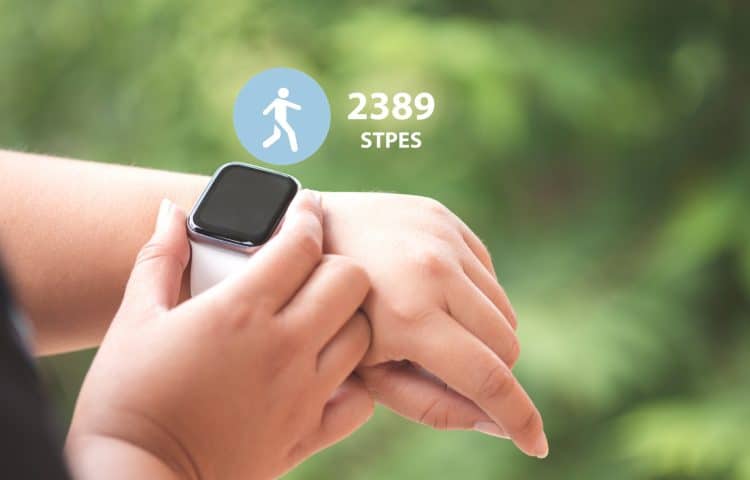Most smartphones log your daily steps. iPhone users can access this data in their phone’s Health app. It will also give you your daily, weekly, monthly, half-yearly, and yearly step count. If you look hard and long enough, you’ll find these features tucked away somewhere in Android phones, too.
But why are the number of steps I take each day so important, you ask?
Daily step count is one of the most accessible methods to monitor and set physical activity goals.
A lack of physical activity can hamper your overall health. A study published in Medicine & Science in Sports & Exercise found an inverse dose-response relationship between daily steps and health outcomes such as all-cause mortality, cardiovascular events, and type 2 diabetes. (1)
Many people have heard about the 10,000-steps-a-day goal. The biggest advantage of this challenge is that most people cannot complete it in a single session. You’ll have to break it into smaller sessions throughout the day, ensuring constant physical activity.
While the 10,000 daily step goal is gaining popularity, only a few people know how many miles it includes.
Level Up Your Fitness: Join our 💪 strong community in Fitness Volt Newsletter. Get daily inspiration, expert-backed workouts, nutrition tips, the latest in strength sports, and the support you need to reach your goals. Subscribe for free!
I have worn a fitness tracker daily for the last three years and have invaluable step-counting data and insights to share with you.
In this article, we will go over everything you need to learn about how many steps make up a mile (and much more). We have a lot to cover, so buckle up!
Calculating Steps in a Mile: A Step-by-Step Approach
Figuring out how many steps are in a mile really boils down to understanding your own stride length, which varies from person to person. Factors like height and walking speed play a significant role in this. Generally, an adult’s stride is about 2.1 to 2.5 feet long. So, on average, you’re looking at walking around 2,000 to 2,500 steps to hit that mile mark. If you’re on the shorter side, your steps might be a bit smaller, whereas the taller folks usually take bigger strides. And don’t forget, the way you naturally walk affects this too. (2)
Your steps per mile = Total distance in feet (5,280 feet in a mile) / Your stride length in feet
Here’s a simple way to figure out your steps per mile: Take the total distance in feet (that’s 5,280 feet for a mile) and divide it by your stride length in feet. For instance, let’s say your stride is 2.5 feet. You’d do the math like this: 5,280 divided by 2.5, which comes to about 2,112 steps per mile. And if you’re aiming for those famous 10,000 steps a day, you’re covering close to 4.73 miles.
I remember when I first tried measuring my stride length. I picked a set distance and counted each step I took. After reaching the end, I divided the total distance by my step count to find my average stride length. It was an eye-opener and really helped me understand my walking patterns better. If you walked 100 feet and it took you 40 steps, your stride length is 2.5 feet (100 divided by 40).
The most reliable source for your stride length is your iPhone Health app’s ‘Walking Step Length’ data source. The app will spit out your average walking step length in centimeters or inches.
However, you must do some elementary-level arithmetic to convert the step length into stride length. Multiply your step length by two to get your stride length. Let’s say your walking step length is 64 cm (2.1 feet); your stride length will be 128 cm (4.2 feet).
You can also get this data from Garmin or Fitbit apps.
Coach’s Tip: Avoid using generic ‘steps in a mile’ tables that don’t account for your height, gender, age, fitness level, and stride length. Calculating your stride length using the way explained above might require a little effort, but this will give you the most accurate results.
Variations for Different Activities: Walking, Running, Hiking
How many miles you cover by walking 10,000 steps can vary depending on the type of activity. Here is a lowdown on each:
Walking:
Most people walk at a steady, moderate pace. Walking typically involves a shorter stride length than running, resulting in a higher step count per mile. Factors like walking speed, terrain, and individual fitness levels can further influence this number.
Running:
Running can lead to very different steps per mile numbers. As you start running, you can log in more miles due to longer stride lengths, reducing the number of steps per mile. However, as fatigue starts to set in, your steps per mile will go up while the distance covered decreases. (3)
Notably, running form and efficiency are crucial in determining the steps per mile. For instance, an average jogger might take around 1,700 steps in a mile, whereas a competitive runner might require fewer than 1,500 steps.
Hiking:
Some people prefer hiking over going out for walks or running. Hiking is just as good as the other two activities detailed above. Remember, the goal is to stay active and choose activities that you can stick to for the long term. You don’t want to sign up for activities that don’t gel with your lifestyle. Doing so increases the risk of falling off your fitness journey.
Hiking is different than running and walking. The uneven terrain, inclines and declines, and obstacles shorten the stride length, increasing the step count per mile. You must also consider factors like backpack weight, trail difficulty, and elevation changes. Hiking in a rugged mountainous area will differ significantly in step count compared to a gentle, rolling hill hike.
Coach’s Tip: If you want to zero down on your step count number, you must invest in a pedometer or a step-tracking app. I recommend choosing between an Apple Watch or a Garmin, as these two consider multiple variables and provide the most reliable data.
Practical Application
Knowing the differences in step counts for running, walking, and hiking is invaluable. It allows you to adjust your training intensity, volume, and frequency and set and achieve realistic daily and weekly step goals.
Understanding the Step-Mile Connection
Staying up to date with the latest ground-breaking scientific research isn’t absolutely necessary to lose weight and keep it off. Mastering the basics will get you the desired results.
At the same time, I realize that ‘mastering the basics’ can be very vague and confusing. One of the first things beginners must do is keep an eye on how many steps they take each day. But this isn’t just about counting; your daily step count offers a glimpse into your overall physical activity and its impact on your health.
Did you know the concept of walking 10,000 steps a day dates back to 1965? It has since become a worldwide standard in health and fitness. It’s fascinating how this number, initially just a marketing idea for a Japanese pedometer, turned into a global health goal. (4)
Using the stride length formula we discussed earlier, someone with a 2.64-foot stride would cover about five miles by walking 10,000 steps. Of course, this number can change based on how you walk or run.
Understanding this metric for yourself is pretty insightful. You get to appreciate the unique aspects of your physical activity levels.
The Basics of Counting Steps
The human interest in step counting isn’t a modern obsession. It’s a centuries-old practice. Originally, step counting was a practical solution for estimating distances traveled on foot.
The ancient Romans, known for their meticulous planning and engineering, used a device similar to today’s pedometer. They called it a ‘pedometer,’ which was crucial for military campaigns and building those famous Roman roads. These early pedometers were vital tools, helping to measure the Roman Empire’s expansion — one step at a time.
The term ‘mile’ originates from the Latin word ‘mille passus,’ meaning a thousand paces or steps.
Step counting has sprung back to life with the rise of digital pedometers and fitness trackers. Most smartphones have built-in fitness trackers and pedometers to track basic and essential health markers like step counts. These features take health and fitness tracking to the masses, as they can now set realistic and personalized fitness goals for themselves.
Step counting, in particular, has become the benchmark for tracking and comparing daily activity levels. Furthermore, it suits people with varying fitness objectives. Step counting offers a tangible and straightforward way to measure progress for people aiming to improve cardiovascular health, an athlete integrating aerobic training into their regimen, or someone monitoring their activity for weight management.
Factors Influencing Steps Per Mile
Before you calculate how many steps make a mile, you must be familiar with the following factors, as these can influence the overall outcome:
Stride Length: How It Varies and Why It Matters
Stride length is the factor of your height, weight, leg length, and gait, and it will determine how many steps you must take to cover a mile. It’s the distance covered from the heel of one foot touching the ground to the heel of the same foot touching again.
Level Up Your Fitness: Join our 💪 strong community in Fitness Volt Newsletter. Get daily inspiration, expert-backed workouts, nutrition tips, the latest in strength sports, and the support you need to reach your goals. Subscribe for free!
An average adult has a stride length of about 2.1 to 2.5 feet, meaning it typically takes over 2,000 steps to walk a mile. Understanding your stride length can help you tune your cardio workouts to meet your needs.
Walking vs Running: A Comparative Analysis
How you move significantly changes your step-to-mile ratio. Stroll and it will take many more steps to cover a mile than sprinting through the one-mile mark. An average person walks a mile in 2,000 steps but can run the same distance in 1,000-1,500 steps.
The term ‘mile’ originated from the Latin ‘mille passus,’ meaning a thousand paces or steps. The Latins were for sure sprinting when they were measuring and naming miles. Knowing the step-to-mile ratio is invaluable for people training for endurance.
Individual Differences: Age, Height, and Fitness Level
The stride length and, consequently, steps per mile for each individual can vary depending on their age, height, weight, gait, and fitness level. Taller people generally have longer strides and can cover a mile in fewer steps than shorter people. Fitter folks tend to have longer and more efficient strides. Furthermore, older individuals usually have shorter strides than their younger counterparts.
Technology’s Role: Pedometers and Smartwatches
Folks who don’t want to do manual calculations to calculate their stride length can use the relevant fitness app on their phone to check this data. Most smartphones have a built-in pedometer that has up-to-date stride length data.
My Health app tells me my stride length is 4.2 feet. Check your stride length and drop it in the comments below. I’d love to see what you guys are clocking.
Health Benefits of Step Counting
Counting steps has several benefits, including:
Setting Realistic Goals
Knowing how many steps make up a mile helps you set tangible, achievable fitness goals. Understanding the step-to-mile conversion empowers you to choose between the popular 10,000-steps-a-day target or a personalized goal based on your health recommendations.
If you aim to walk 5 miles daily, knowing how many steps make a mile helps you quantify your objective. It makes setting and tracking your goals and progress easier. Plus, it helps build confidence in your cardiovascular abilities.
Cardiovascular Health
Regular walking or running improves your cardiovascular conditioning immensely. A scientific review in Current Opinion in Cardiology concluded that “walking has the potential to play a key role in the primary and secondary prevention of cardiovascular disease. Longer term benefits include reduced risk of CHD, coronary events and mortality.” (5)
The American Heart Association suggests doing at least 150 minutes of moderate-intensity aerobic activity per week or 75 minutes per week of vigorous aerobic activity. You could easily measure these in steps and do the equivalent work in walking or running workouts. (6)
Tracking Progress and Motivation
I like pushing my limits by trying to surpass my top distance of 10,000 steps every two weeks. It requires me to run faster using bigger strides. Although I don’t beat this goal each month, it pushes me to the limits.
Converting your steps into miles gives you a clearer perspective of your accomplishments. It also helps you understand the effort required to reach further milestones. If you can walk a mile in 2,182 steps, try covering the same distance in 2,000 steps the next time. Making such improvements is usually easier while running. Taking bigger strides while walking can feel unnatural.
Specificity for Various Fitness Disciplines
Understanding the step-to-mile conversion allows athletes and fitness enthusiasts to integrate and tailor cardiovascular activities more effectively into their training regimen.
Let’s say you want to walk 2,200 steps on the treadmill to meet your daily 10,000-step goal. However, all the treadmills at your gym are occupied. Knowing the step-to-mile conversion, you could log a mile (equivalent to 2,200 steps) on an elliptical.
Health Tracking and Management
For health management, especially for those with specific medical conditions like heart disease or obesity, knowing how many steps are in a mile helps meticulously track physical activity. Furthermore, your doctors can better assist you if you can tell them the specifics of your physical routine.
Mental Health
Walking and running are some of the best ways of clearing your mind. Many people I know know exactly how many steps (or distance) they need to take before noticing mental clarity and relaxation.
A Computational Intelligence and Neuroscience study found that “individuals who even smoke and drink can improve their health by adding walking to their routine life. The scores of PSS (perceived stress score and ESS (Epworth sleepiness score) are improved by 10% or more on average, which shows that people can reduce stress and improve their sleeping score by walking.” (7)
Elderly and Rehabilitative Exercise
Young people have several options to get more physical activity than seniors. Walking is one of the best physical activities for the seniors. It is joint-friendly and delivers all the health benefits of more physically intense exercises. Knowing how many steps make up a mile can help seniors stay more consistent with their fitness routines.
Reduced Mortality Risk
Per National Institutes of Health research, “adults who took 8,000 or more steps a day had a reduced risk of death over the following decade than those who only walked 4,000 steps a day.” (8)
Furthermore, the association between higher step counts and lower rates of death from heart disease and cancer was consistent across various demographic groups, including different ages, sexes, and races. Meaning that no matter who you are, what you do, and where you live, walking more will help improve your overall health and longevity.
Practicality and Accessibility
The best thing about walking more is that there are no barriers to entry, and you don’t need specialized equipment, clothes, or training for it. You could add more activity to your daily life by making small adjustments. Since it is a low-impact form of exercise, the chances of injury are incredibly low.
One of the things that I love the most about walking more around my neighborhood while on my mission to hit my daily step count goal is that I discover many new things around my home — be it a salon, a car wash center, or a florist. Walking makes you slow down and appreciate the things around you. It is something you don’t actually understand until you start doing it.
Enter a Calorie Deficit
Entering a calorie deficit is key to weight loss. Walking is one of the most underrated ways of entering a calorie deficit. A 180-pound individual can burn around 150 calories in 30 minutes of walking at 3 mph. On the other hand, he can shed 214 calories walking at 4 mph.
Want to learn how many calories you can burn with an outdoor walk? Check out our convenient Calories Burned Walking Calculator.
Overcoming Common Misconceptions
Stay clear of these two misconceptions:
You Must Achieve a Perfect Stride Length
Since we are talking a lot about stride lengths, it’s important to remember that there is no one optimal stride length. Increasing your natural stride length while walking isn’t going to get you additional health and fitness benefits. Use your stride length to calculate how many steps you must take to cover a mile. Plus, you can challenge yourself to run a mile in fewer steps than you did the last time.
Clarifying Misunderstandings About Overall Fitness and Step Count
Contrary to what most people think, more steps aren’t always better for improving your overall fitness. Here is an unpopular opinion — you might not need to log 10,000 to improve your fitness levels.
Your overall fitness has several moving pieces. Balancing step count with other forms of exercise, such as isometric, plyometric, and weight training, and a healthy lifestyle is essential for comprehensive fitness.
Enhancing Your Step Counting Experience
Here are a few tips to improve your step-counting experience:
Tips for Increasing Daily Steps
You can boost your daily step count by making small lifestyle changes, like opting for stairs instead of elevators, parking further from your destination, or taking short walking breaks throughout the day.
Incorporating Steps into Various Lifestyles and Routines
Small nudges like phone reminders can help improve your consistency. Folks with desk jobs should set reminders to walk every few hours, and if that’s not possible, use an under-desk treadmill to get in more steps.
The Science Behind Step Counting and Energy Expenditure
Overlooking the real reasons behind counting steps and forgetting why we are doing it in the first place is easy — I was guilty of doing this, too. Step counting isn’t just about reaching a number; it helps you stay active throughout the day and burn calories.
FAQs
Is running more effective than walking for losing weight?
The effectiveness of running and walking will vary depending on the intensity, duration, and individual fitness levels. While running can help burn more calories than walking in a specific period, it might not be suitable for people with lower body joint issues.
Remember, the best training program is the one that you enjoy and can sustain for the long term. Also, you don’t have to pick between the two. You can alternate between running, walking, and even hiking to meet your fitness goals. Doing the right things consistently is vital for achieving your transformation objectives.
What is a realistic step and mile goal for a beginner?
Beginners should start with a modest step goal, such as 5,000 steps per day, and gradually increase their target step count by 500 to 1,000. Adjust your step goals according to your fitness level and lifestyle. More active individuals should aim for the coveted 10,000 steps-a-day goal.
Could I be walking too much?
Absolutely! You might be walking too much if you feel nagging ankle, heel, knee, or shin pains. Although walking 10,000 steps a day should be your ultimate goal, you shouldn’t rush into it. Give yourself enough time to ease into this big-hairy audacious goal, as overuse injuries can take a long time to heal and hamper your overall health and fitness levels.
Learn to listen to your body and take your foot off the gas if your recovery is compromised. Back your step goals with proper hydration, nutrition, and footwear.
Wrapping Up
Understanding the number of steps in a mile is crucial for anyone tracking their daily activity, whether for fitness goals, health monitoring, or simply for the satisfaction of hitting that 10,000-step daily target.
If you could take only one thing from this article, let it be this — an average person can walk a mile in around 2,000 steps, whereas they can run the same distance in 1,000 to 1,500 steps.
Do you have any questions about how many steps in a mile? Drop them in the comments below, and I’ll be happy to help!
References
- Kraus WE, Janz KF, Powell KE, et al. Daily Step Counts for Measuring Physical Activity Exposure and Its Relation to Health. Med Sci Sports Exerc. 2019;51(6):1206-1212. doi:10.1249/MSS.0000000000001932
- Murray, M.P., Drought, A.B., & Kory, R.C. (1964). WALKING PATTERNS OF NORMAL MEN. The Journal of bone and joint surgery. American volume, 46, 335-60.
- Cavanagh PR, Kram R. Stride length in distance running: velocity, body dimensions, and added mass effects. Med Sci Sports Exerc. 1989 Aug;21(4):467-79. PMID: 2674599.
- Calechman, S. (2019, July 11). 10,000 steps a day – or fewer. Harvard Health Blog.
- Murtagh EM, Murphy MH, Boone-Heinonen J. Walking: the first steps in cardiovascular disease prevention. Curr Opin Cardiol. 2010;25(5):490-496. doi:10.1097/HCO.0b013e32833ce972
- American Heart Association. American Heart Association Recommendations for Physical Activity in Adults and Kids.
- An, N., & Chuo, J. (2022). Walking and Activeness: The First Step toward the Prevention of Strokes and Mental Illness. Computational Intelligence and Neuroscience, 2022.
- National Institutes of Health. Number of steps per day more important than step intensity. National Institutes of Health (NIH). March 31, 2020.












